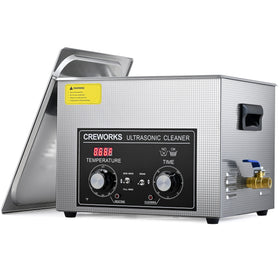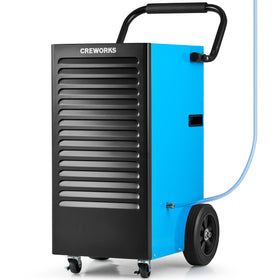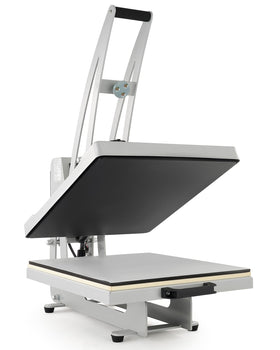With over 10000+ orders
With over 10000+ orders
Ultrasonic cleaners are becoming more popular for use at home, especially for cleaning glasses and other fragile items. Clear eyeglasses are important for both good eyesight and good looks. This guide introduces some basic information regarding the use of ultrasonic eyeglass cleaners. With this information, you will be ready to make the perfect choice for your eyeglass ultrasonic cleaner.
An ultrasonic cleaner is a cleaning device that uses ultrasound technology to clean items. This device works through the process of cavitation: high-frequency sound waves (20–400 kHz) make tiny bubbles in the liquid. When these bubbles pop, they push down hard on the things submerged in the cleaner, successfully removing dirt and debris. The main parts of an ultrasonic cleaner are the tank where the items are stored, the generator that changes electricity into ultrasonic waves, the sensors that send out these waves, and the cleaning solution that makes the cleaning work. This high-tech setup makes it perfect for cleaning complicated things, making sure they are cleaned carefully without any damage.
Wiping eyeglasses clean with cloth or spray cleaners can leave behind leftovers and streaks, and they may also damage delicate parts like frames and coated lenses. Ultrasonic eyeglass cleaning is a better option that has a number of advantages:
Efficiency: Ultrasonic cleaners for eyeglasses can get rid of dirt, oil, and leftovers well, so your eyeglasses are clean all the way through.
Safety: The eyeglass ultrasonic cleaner's gentle action is safe for delicate parts because it doesn't touch them directly.
Thoroughness: Ultrasonic waves clean places that are hard to reach since they can go into every corner.
There are some factors you should think about when looking for the best ultrasonic cleaner for eyeglasses. You can keep these important things in mind:
For cleaning eyeglasses, the frequency of the ultrasonic waves is very important. Generally, higher frequencies can offer even gentler cleaning, and frequencies around 40 kHz are good for cleaning a lot of different things, including eyeglasses, because they are strong enough to get the job done but not too harsh on delicate items. The power of the cleaner determines the intensity of the cavitation process. Increased power can lead to faster and more comprehensive cleaning, however, excessive power may harm fragile items.
The size of the tank of your ultrasonic cleaner should be sufficient for your glasses to be fully submerged in. If the tank is too small, some parts of the glasses won't get cleaned. Generally, a 2 or 3L ultrasonic eyeglass cleaner is enough for individual use.
The materials used to make the ultrasonic cleaner affect its longevity and safety. Look for cleaners with tanks made of stainless steel, which is strong and doesn't rust. Plastic exteriors should be sturdy and heat-resistant to ensure longevity and safe operation.
After discussing some key factors to consider when looking for the best ultrasonic eyeglass cleaner, it is time to be introduced to two excellent ultrasonic eyeglass cleaners from which you can make a perfect choice.
This ultrasonic cleaner is designed with a rust-proof stainless-steel tank that can ensure durability and heat resistance. It operates with a powerful 40 kHz transducer that can create lots of microscopic cleaning bubbles, efficiently removing dirt from delicate eyeglass components. The cleaner also features an adjustable heating function that can be set up to 80°C, helping to dissolve stubborn oil stains and enhancing the cleaning process.
Building on the strengths of the 2L model, the 3L version offers a larger capacity, making it ideal for those with multiple pairs of glasses or larger eyewear. It shares the same high-quality stainless-steel construction and powerful 40 kHz cleaning frequency, which ensures thorough cleaning without damage. Besides, it is easier to use. After setting the parameters and pressing the power button, the ultrasonic cleaner will immediately work and swiftly clean your eyeglasses within minutes.
Although ultrasonic cleaning is a precise process, to avoid common mistakes, meticulous attention to detail is needed. Here are some typical mistakes that users may make and some tips on how to avoid them.
People may mess up when they use the wrong kind of cleaning product, which can damage the eyeglasses they are trying to clean or not clean well. Always use cleaning solutions that are made for eyeglass ultrasonic cleaners, and make sure that the cleaning solution is also safe for the eyeglasses that you want to clean. For glasses, make sure the solution is gentle and contains no strong chemicals that could harm the lens coatings.
Too many things in the cleaner's tank can stop the ultrasonic waves from moving around properly. To prevent this, make sure the items are all on the same layer and don't touch. Also, leave enough space around each item for the solution to flow freely.
Always check the manufacturer's instructions to see the best settings for eyeglasses. For instance, an excessive temperature may damage eyeglasses with easily damaged coverings.

Ultrasonic cleaners for eyeglasses offer an effective solution for keeping your glasses clear and spotless. Consider investing in a Creworks ultrasonic cleaner for eyeglass to ensure your eyewear receives the best possible care now.











